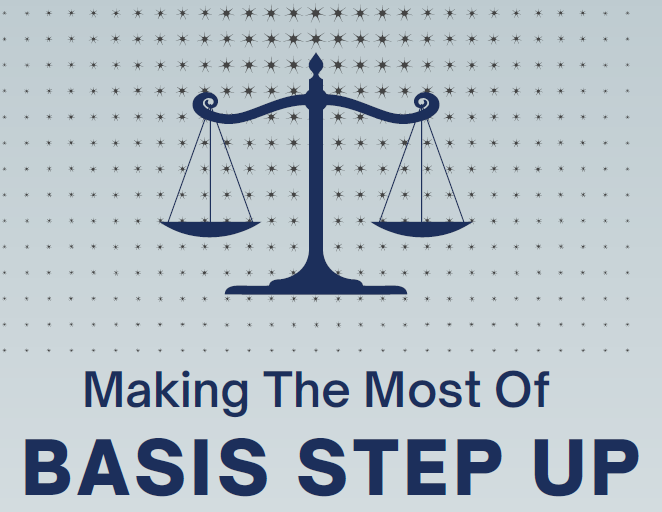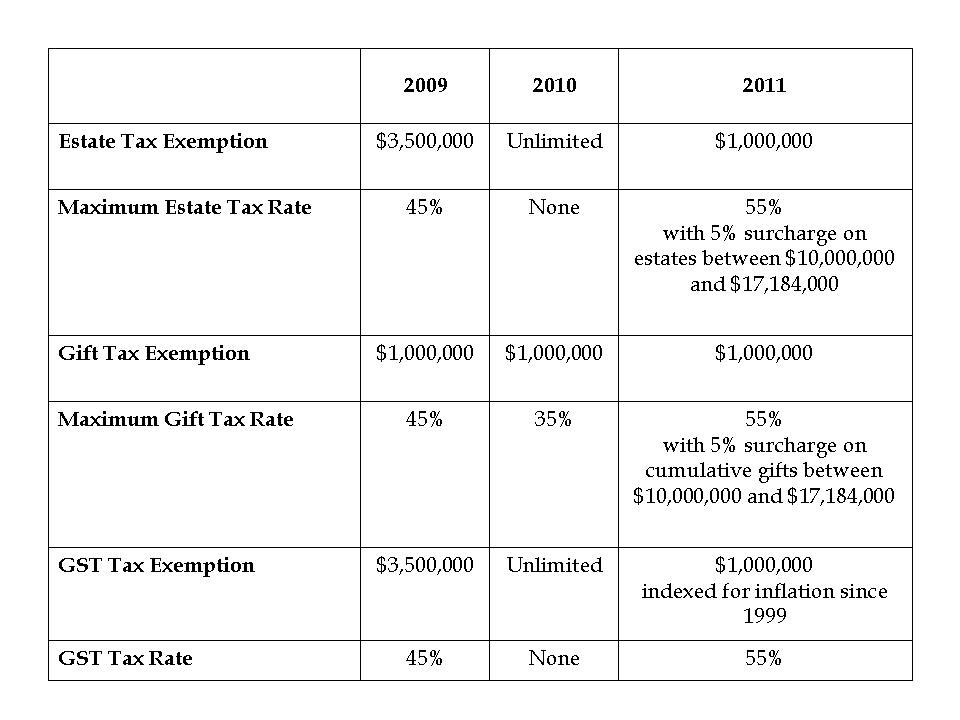
The current rules for the federal estate tax mean most Americans are unaffected — but with a potential end date for the current rules in 2026, some affluent taxpayers are trying to make the most of the current situation. Large lifetime gifts, however, may mean giving up a powerful estate planning tool: stepping up assets’ cost basis.
While lifetime gifts and bequests are equivalent when it comes to the federal lifetime exemption for estate tax, they are very different when it comes to capital gains tax. This difference means that taxpayers, especially married couples, should think carefully. To make sound decisions, taxpayers need to first understand the advantages and disadvantages of various strategies.
The Basics Of Basis
At its simplest, “cost basis” is the original value of an asset for tax purposes. Stocks serve as an easy-to-understand example: If you purchase shares in a company, the price you originally paid for the shares is your basis. When you later sell them, comparing your basis to the price you got for your shares allows you (and the tax authorities) to determine whether you experienced a capital gain or a capital loss. If the shares are worth more than your basis, you realized a capital gain and may owe tax; conversely, if you sold the shares for less than your basis, you had a capital loss, which you may be able to use to offset tax on other gains.
Of course, not all transactions are this straightforward, and not all of them involve sales. What if you received the asset as a gift or inherited it from someone who died? The Internal Revenue Service treats these two scenarios differently. If someone gives you an appreciated asset as a gift, your cost basis equals the giver’s basis as of immediately before the gift. Essentially, the giver is giving you the asset with its appreciation baked in. The rules for depreciated assets are different and unfavorable, with the result that most people avoid giving depreciated assets as lifetime gifts at all.
Inherited assets, however, generally receive “basis step-up.” Say your grandmother left you stocks that she bought decades ago. Compared to your grandmother’s basis, the stocks are highly appreciated. However, with basis step-up, your basis becomes the fair market value — what a knowledgeable buyer would pay a knowledgeable seller — as of the day your grandmother died. The appreciation relative to your grandmother’s basis is wiped out. You will, instead, only recognize any gain or loss that occurs after the date of your grandmother’s death. It is easy to see, therefore, the ways in which basis step-up can serve as a powerful estate planning tool.
Basis For Married Couples
Married couples face several potential complications when it comes to resetting their basis. This is because they often own assets jointly. Note that individuals don’t have to be married to jointly own assets; some of the rules I will describe in the following section work differently for unmarried co-owners, however. It’s especially wise to consult an estate planner or tax expert if your estate includes property you own with someone other than your spouse.
In many parts of the U.S., a common way to co-own assets is “joint tenancy with rights of survivorship,” often abbreviated JTWROS. Assets commonly owned through a JTWROS arrangement include real estate, vehicles and investment accounts. In the eyes of the law, if you and your spouse own something this way, only half the asset is included in the estate of the first spouse who dies. This is true regardless of how much each of you contributed to purchasing the asset. The survivor will receive a basis adjustment on half of the property’s fair market value; the other half’s basis will remain unchanged.
Tenancy by the entirety is a similar way to jointly own property available in certain states. Instead of each spouse legally owning half of the property, in a TBE arrangement, both legally own 100% for many purposes — but not for the purposes of basis step-up. As with JTWROS, half of the asset’s value is included in the estate of the first spouse who dies, so only half of the asset’s basis resets.
Both JTWROS and TBE arrangements are opt-in choices that couples can make. Residents of nine states, however, are automatically subject to community property laws that can also affect basis for married couples. While the specifics of the laws vary, in general community property states consider any property a couple acquires during their marriage to be communal: Each spouse essentially owns 100% of such property. Unlike TBE, community property can result in a full basis step-up for the survivor when the first spouse dies.
In addition to the nine states that mandate community property — Arizona, California, Idaho, Louisiana, Nevada, New Mexico, Texas, Washington and Wisconsin — several others allow couples ways to voluntarily choose community property treatment. The newest of these is Florida, which recently introduced Florida Community Property Trusts. This arrangement is new enough that there is some uncertainty about IRS recognition for these arrangements, so some caution is worthwhile for Florida residents hoping to use these trusts to secure full basis step-up. Optional community property rules also exist for couples in Alaska, Kentucky, South Dakota and Tennessee.
Income Tax Concerns vs. Estate Tax Concerns
Basis step-up is an inarguably powerful tool for tax planning. But high net worth taxpayers and couples should take a step back and evaluate their estate plans in a holistic way. This is because strategies that reduce income tax can sometimes have federal estate tax consequences, and vice versa.
For the past decade or so, the lifetime exemption for the federal estate tax has been high enough that few people have needed to worry about estate tax at all. As of 2023, the unified exemption for gifts and estates is $12.92 million. Considering that taxpayers also have access to gifts under the annual exclusion amount — $17,000 per recipient per year as of 2023 — and gifts in any amount to a spouse as long as the recipient spouse is a U.S. citizen without affecting their lifetime exclusion, federal estate tax has been easy to ignore for some time.
Yet the possibility of reform is always present. If Congress does not extend the provisions of 2017’s Tax Cuts and Jobs Act, they will sunset at the end of 2025. One of these provisions is the current level of the lifetime exemption amount. If lawmakers do not intervene, in 2026 the exemption will fall back to its previous level. Adjusted for inflation, this is expected to be around $7 million. A lower threshold could expose many taxpayers to federal estate tax.
Depending on the makeup of Congress and the occupant of the White House, even more extreme changes are possible. President Joe Biden campaigned in 2020 on the promise to lower the lifetime exemption to $3.5 million per taxpayer. It is wise to take campaign promises with a grain of salt; Biden’s plan did not materialize, even with a Democrat-controlled Congress during the first years of his term. Even so, this rhetoric served as a reminder that the future is not promised when it comes to any tax law, including the estate tax.
Still, for most people income taxes remain more relevant than estate taxes. That said, for taxpayers who might be affected if the exemption amount drops, it is worth considering potential trade-offs. Making lifetime gifts will allow individuals and couples to capitalize on the current large exemption amount, but they mean forgoing the benefits of a step-up in basis. Couples who live in community property states, or who have opted in to available community property regimes, may find the basis step-up especially compelling and worth the risk of leaving behind a larger (and potentially taxable) estate.
Lifetime gifts can also raise questions of future treatment if the lifetime exemption does change. The IRS has made clear that taxpayers who give away amounts in excess of the potentially lower 2026 exemption will not be penalized by clawbacks. However, taxpayers may still need to be mindful of gifts’ potential future impacts. Proposed regulations would make certain sorts of gifts exceptions to the anti-clawback rule, potentially including certain types of revocable transfers (such as to revocable trusts) and certain transfers made within three years of the giver’s death. While the prospect of clawbacks across the board has been addressed, the particular details could trip up some taxpayers.
It is also worth remembering, when balancing risk and reward, that the federal estate tax is substantially higher than the tax on long-term capital gains. Estate tax is generally 40% on the portion of the estate exceeding the lifetime exemption, while the highest rate for federal capital gains is 20% (with a few specific exceptions). Taxpayers, married or single, who think they may need to balance the pros and cons would do well to speak to a financial professional who can help them to consider various potential scenarios. Every taxpayer’s situation is unique. However, there are a few strategies that some couples may want to consider.
Making The Most Of Basis Step-Up
If you and your spouse decide to weigh your strategies in favor of securing the maximum basis step-up, you have several options. First, be mindful when deciding how to title property. As I said earlier in this article, TBE and JTWROS arrangements mean assets are split evenly. If you do not live in a community property state, you may want to hold certain assets fully in one spouse’s name. This does mean, however, that if the spouse holding the asset doesn’t die first, the surviving spouse won’t receive even 50% of the step-up. Alternatively, if you live in a state where optional community property rules are available to you, they may be attractive since they allow for a full basis step-up on the first spouse’s death.
For couples outside community property states, a “transfer-and-inherit” strategy may also be useful. This is an especially attractive strategy if it is very likely one spouse will survive the other — for example, due to a significant age difference or when one spouse has a serious ongoing health issue. In such a scenario, the couple could transfer all or most of the couple’s assets into the name of the spouse expected to die first. This would include all the transferred assets fully in that spouse’s estate, securing a full basis step-up if they are left to the surviving spouse.
There are some major caveats for this approach, however. First, the IRS requires that the spouse who received the assets must own them for at least one year for the survivor to receive a step-up in basis. This can create problems if the spouse in question already is coping with a potentially terminal illness, or if the individual’s health takes an unexpected turn for the worse soon after the transfer. It is also important to remember that giving a gift means sacrificing control. If you are the spouse transferring property, you will have to trust that your partner will leave it to you if that is what you arranged. Your partner, however, has no legal obligation to do so (beyond potential restrictions in state law, as some states require a portion of an estate to go to an otherwise disinherited spouse).
If your estate would likely exceed the lower exemption level that could return in 2026, you and your spouse may consider using trusts for assets you plan to leave to beneficiaries such as your children. This is a sensible approach, especially if the assets in question are appreciating rapidly and pushing you closer to the estate tax threshold. However, you may regret losing the advantages of basis step-up. The trust would retain your original basis, and would potentially owe capital gains tax upon selling the assets. A similar problem applies to lifetime gifts. Depending on the particulars of your family, you may want to consider “upstream” gifting as a solution.
Say your parents are still alive, but their estate is smaller than even a potentially lower estate tax exemption. If your relationship with your parents allows, you could give them the assets with the understanding that they will make a corresponding bequest to your children. This allows you to make a lifetime gift while the exemption is still high. Assuming your parents simply hold the assets until their death, your children will also receive the step-up in basis as you hoped.
As with the transfer-and-inherit approach, it is critical to remember that gifts mean giving up control. If your parents decide they need to tap those assets for themselves, or want to leave them to someone other than your children, they have the legal right to do so. Similarly, if your parents simply fail to update their estate plans, your strategy may not work as you intend. The assets will also be vulnerable to your parents’ creditors, if any.
You may want to consider making gifts to revocable trusts, which generally do not remove assets from your estate. The particulars will depend on your goals. Just bear in mind that irrevocable trusts can remove assets from your estate, making them useful if you worry about the federal estate tax but necessarily sacrificing the possibility of a basis step-up just as a gift to an individual would. When considering ways to fund a trust, especially for the benefit of your spouse or another noncharitable beneficiary, remember to weigh the benefits and drawbacks for both estate and income tax purposes. And speaking of charities, don’t forget that donating appreciated assets directly to tax-exempt charities can be an alternative way to handle highly appreciated assets if you have philanthropic leanings.
As I hope I’ve made clear, balancing the benefits of lifetime gifts and bequests that receive a step-up in basis is a complicated exercise. What is right for you will depend on factors including your family composition, your overall financial situation and your philanthropic goals, if any. But taking the time to weigh the benefits and drawbacks of different approaches can help you make the most of the current regulations without neglecting long-term concerns.










